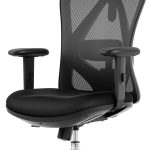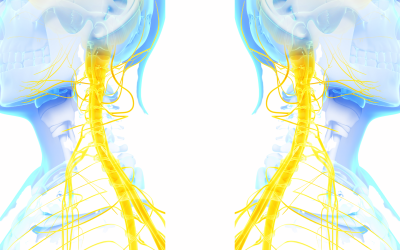
80° to 90° of flexion, 70° of extension, 20° to 45° of lateral flexion, and up to 90° of rotation
What is the neck range of motion and why is it important?
The neck is a part of the spine, and as such, it is responsible for supporting the head and protecting the spinal cord. The cervical spine is the section of the spine that is located in the neck. The neck is made up of 7 cervical vertebrae in total. Morphologically and functionally, the cervical column is divided into two distinct regions: the upper cervical spine, and the lower cervical spine.
The cervical spine’s range of motion is approximately 80° to 90° of flexion, 70° of extension, 20° to 45° of lateral flexion, and up to 90° of rotation to both sides. However, movement in the cervical spine is a complex play of motion between the upper and lower cervical spines.
The cervical spine is designed for a relatively large amount of mobility. Normally, the neck moves 600 times every hour whether we are awake or asleep. This means that the range of motion of the neck is crucial as a lack of range would hamper the smooth functioning of our activities of daily living. Additionally, a severe lack of range of motion at the cervical spine may also restrict the field of vision.
While the cervical region demonstrates the most flexibility of any of the regions of the vertebral column, stability of the cervical region is essential for the support of the head and protection of the spinal cord and vertebral arteries.
What affects the range of motion of the neck?
The cervical range of motion can be restricted due to bony or soft tissue causes. These can be due to physiological limitations or pathological aetiologies. Most commonly, due to the rise in the use of cell phones and increased computer screen times, prolonged poor posture is the leading cause of pain that increases muscular stiffness around the neck and reduces range of motion of the cervical spine. The term “Tech Neck” has been used to describe a range of neck pain issues due to the rise in technology use.
How do you measure neck range of motion?
Neck range of motion can be measured by anatomical movements flexion, lateral flexion, extension, and lateral flexion.
Range of motion of the neck is usually measured using a goniometer. You can measure range of motion of the neck using Check My ROM, a free online tool that measures range of motion using images.
Neck Lateral Flexion
Neck Lateral Flexion, or Cervical Spine Lateral Flexion, is the movement of the head and neck to the side, as if you were trying to touch your ear to your shoulder.

Click here to measure Neck Lateral Flexion.
Neck Rotation
Neck rotation is turning your head to the side, such as looking both ways before crossing a road
Click here to measure Neck Rotation
Neck Flexion
Neck Flexion, or Cervical Spine Flexion, is the movement of the head and neck forward and down, as if you were trying to touch your chin to your chest.
Click here to measure Neck Forward Flexion.
Neck Extension
Neck Extension is the movement of the head and neck backwards and up, as if you were looking up at the ceiling.
Click here to measure Neck Extension.
What causes limited range of motion in the neck?
The physiological causes affecting the cervical range of motion are:
- The flexibility of the intervertebral discs
- The shape and angulation of the facet joints of the vertebrae
- The minor laxity of the ligaments and joint capsules all contribute to the cervical spine’s range of motion
- Female patients tend to have a greater active range of motion than males, except in flexion, but the differences are not great.
- The range available decreases with age, except for the rotation at the first and second cervical vertebrae, which may increase.
The limited mobility can be due to pathological causes such as:
- Pain (due to soft tissue trauma or a fracture)
- Muscle dysfunction (due to an imbalance in the cervical flexors and extensors)
- Muscle stiffness and spasm (could happen due to a poor posture or incorrect sleeping habits)
- Nerve impingement (as the spinal cord travels very close to the cervical spine, the nerves exiting the spinal cord may get entrapped and cause pain)
- Ligament rupture (could happen in cases like a whiplash injury. Additionally, ligaments heal with scar tissue)
- Intervertebral disc prolapse (due to trauma or age-related changes, the disc can impinge on the nerves around it causing pain)
- Spinal canal stenosis (narrowing of the spinal canal)
- Vertigo (due to dizziness associated with vertigo, patients may avoid certain cervical movements)
- Spondylolysis (arthritic changes in the spine)
- Spondylolisthesis (one vertebra when slips forward or backward relative to the adjacent vertebra may cause pain)
How to increase range of motion in the neck
Various physical exercises can help increase the range of the cervical spine. (All images are taken from Kisner Carolyn and Lynn Allen Colby. 2012. Therapeutic Exercise : Foundations and Techniques. 6th ed. Philadelphia: F.A. Davis.)
- Chin tucks: It is a simple exercise that can be done at home or at work. Initially, it can be done in a sleeping position with pillows under the head.
- Scapular retractions: this exercise can help with the correction of the position of the scapula (shoulder blade) which has an effect on the position of the neck. To do this exercise, one must try to touch their shoulder blades together
- Trapezius stretching: This exercise helps stretch the trapezius muscle which is known to go into a spasm due to incorrect posture.
- Levator scapulae stretching: this is another common muscle that goes into a spasm along with the trapezius. Stretching it is important to gain a complete cervical range of motion.
- Stretching of the scalenus muscle: Another known muscle that restricts the complete cervical range of motion.










